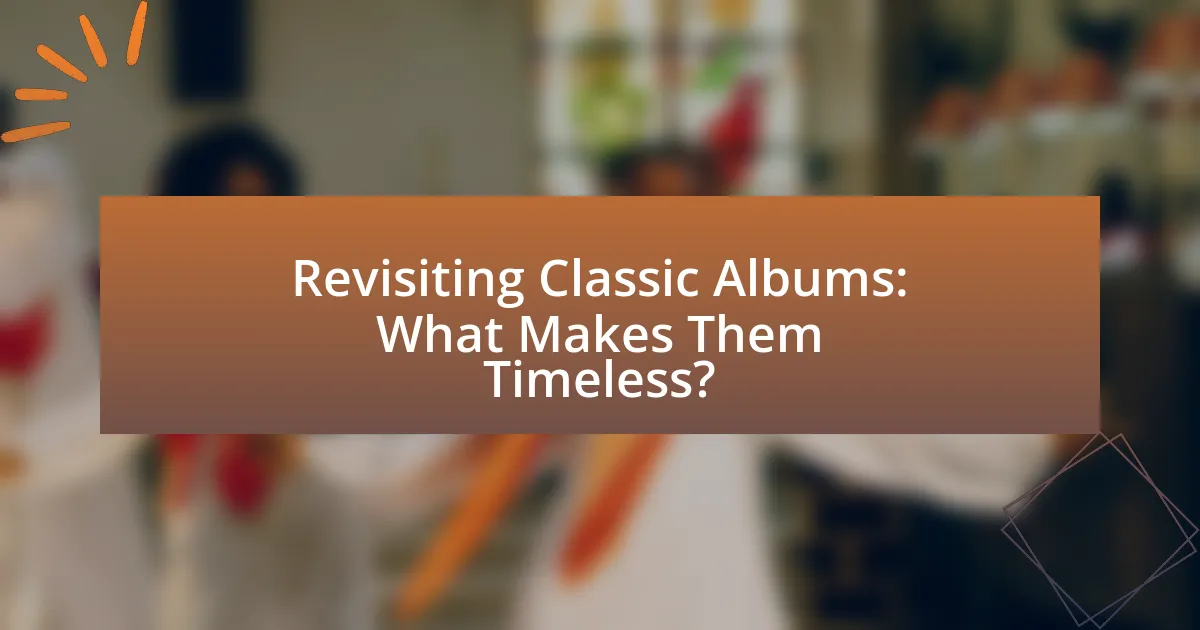Classic albums are defined by their enduring impact, cultural significance, and artistic innovation, resonating across generations and influencing both listeners and artists. This article explores the criteria that determine an album’s classic status, including enduring popularity, critical acclaim, and cultural impact, while examining the role of lyrical depth, musical innovation, and emotional resonance in establishing timelessness. Additionally, it discusses how advancements in technology and production quality contribute to an album’s legacy, alongside the importance of universal themes and storytelling in enhancing listener engagement. The article also provides insights on how to appreciate and revisit classic albums today, emphasizing the significance of context and community discussions in enriching the listening experience.

What Defines a Classic Album?
A classic album is defined by its enduring impact, cultural significance, and artistic innovation. These albums often resonate across generations, influencing both listeners and artists alike. For example, “Sgt. Pepper’s Lonely Hearts Club Band” by The Beatles, released in 1967, is frequently cited as a classic due to its groundbreaking production techniques and its role in shaping the concept of the album as an art form. Additionally, classic albums typically feature memorable songwriting, cohesive themes, and a sound that transcends the era in which they were released, as evidenced by the lasting popularity of Michael Jackson’s “Thriller,” which remains one of the best-selling albums of all time.
How do we determine if an album is considered classic?
An album is considered classic when it demonstrates enduring popularity, critical acclaim, and significant influence on music and culture. The criteria for this classification often include its sales figures, such as achieving multi-platinum status, and its presence on all-time greatest album lists, which are compiled by reputable sources like Rolling Stone and Pitchfork. Additionally, a classic album typically features innovative production, memorable songwriting, and a lasting impact on subsequent artists and genres, as evidenced by its continued relevance in contemporary music discussions and its frequent sampling or homage in new works.
What criteria are used to evaluate the timelessness of an album?
The criteria used to evaluate the timelessness of an album include cultural impact, lyrical depth, musical innovation, and emotional resonance. Cultural impact assesses how the album influenced music trends and societal movements, exemplified by albums like “Sgt. Pepper’s Lonely Hearts Club Band,” which shaped the psychedelic rock genre. Lyrical depth examines the complexity and relevance of the lyrics over time, as seen in Bob Dylan’s “The Times They Are a-Changin’,” which continues to resonate with social justice themes. Musical innovation looks at how the album introduced new sounds or techniques, such as the groundbreaking production in “Pet Sounds” by The Beach Boys. Emotional resonance evaluates the album’s ability to evoke feelings and connect with listeners across generations, a quality evident in albums like “Dark Side of the Moon” by Pink Floyd. These criteria collectively contribute to an album’s enduring legacy and relevance in music history.
How does cultural impact contribute to an album’s classic status?
Cultural impact significantly contributes to an album’s classic status by shaping its relevance and resonance within society. When an album reflects or influences social movements, trends, or collective sentiments, it becomes a touchstone for listeners, enhancing its longevity and significance. For example, albums like “What’s Going On” by Marvin Gaye not only addressed pressing social issues of the 1970s but also sparked conversations about civil rights and environmentalism, solidifying its place in music history. This connection to cultural moments ensures that the album remains relevant across generations, as new listeners discover its themes in contemporary contexts.
Why do certain albums resonate across generations?
Certain albums resonate across generations due to their universal themes, innovative sound, and cultural impact. These albums often address fundamental human experiences such as love, loss, and identity, making them relatable to diverse audiences over time. For example, “The Beatles’ Sgt. Pepper’s Lonely Hearts Club Band” revolutionized music production and introduced concepts that influenced countless artists, ensuring its relevance. Additionally, albums like “Nirvana’s Nevermind” captured the spirit of a generation, reflecting societal issues that continue to resonate today. The combination of emotional depth, musical innovation, and cultural significance solidifies their timeless appeal.
What role do lyrics play in the timelessness of an album?
Lyrics significantly contribute to the timelessness of an album by encapsulating universal themes and emotions that resonate across generations. When lyrics address fundamental human experiences such as love, loss, and social issues, they create a connection that transcends the era in which the album was released. For instance, Bob Dylan’s “The Times They Are a-Changin'” remains relevant due to its commentary on social change, reflecting ongoing struggles for justice and equality. This enduring relevance is supported by studies indicating that music with relatable and poignant lyrics tends to maintain popularity over time, as listeners find solace and understanding in the messages conveyed. Thus, the lyrical content of an album plays a crucial role in its ability to remain impactful and cherished long after its initial release.
How does musical innovation influence an album’s legacy?
Musical innovation significantly enhances an album’s legacy by introducing new sounds, techniques, or concepts that resonate with audiences and influence future artists. For instance, The Beatles’ “Sgt. Pepper’s Lonely Hearts Club Band” revolutionized the use of studio technology and album structure, setting a benchmark for artistic expression in popular music. This innovation not only solidified its status as a classic but also inspired countless musicians and genres, demonstrating how groundbreaking creativity can shape cultural and musical landscapes over time.
What are some examples of classic albums?
Some examples of classic albums include “The Dark Side of the Moon” by Pink Floyd, “Abbey Road” by The Beatles, and “Thriller” by Michael Jackson. “The Dark Side of the Moon,” released in 1973, is renowned for its innovative production and thematic depth, remaining on the Billboard charts for over 900 weeks. “Abbey Road,” released in 1969, is celebrated for its musical experimentation and iconic tracks like “Come Together.” “Thriller,” released in 1982, is the best-selling album of all time, showcasing groundbreaking music videos and a fusion of pop, rock, and R&B. These albums are recognized for their cultural impact and enduring popularity.
Which albums are frequently cited as timeless by critics?
Albums frequently cited as timeless by critics include “Sgt. Pepper’s Lonely Hearts Club Band” by The Beatles, “The Dark Side of the Moon” by Pink Floyd, and “OK Computer” by Radiohead. These albums are recognized for their innovative production, profound lyrical content, and lasting influence on music. For instance, “Sgt. Pepper’s” is often lauded for its groundbreaking approach to studio recording and its cultural impact during the 1960s. “The Dark Side of the Moon” is celebrated for its cohesive concept and sonic experimentation, remaining a staple in music discussions since its release in 1973. “OK Computer” is frequently referenced for its exploration of technology and alienation, solidifying its status as a defining album of the 1990s.
How do fan favorites compare to critically acclaimed classics?
Fan favorites often prioritize emotional connection and popularity, while critically acclaimed classics emphasize artistic merit and innovation. For instance, albums like “Thriller” by Michael Jackson are fan favorites due to their catchy hits and widespread appeal, yet they also receive critical acclaim for their groundbreaking production and influence on pop music. In contrast, albums such as “OK Computer” by Radiohead may not have the same level of mainstream popularity but are celebrated for their complex themes and experimental sound, earning them a place in critical discussions of music history. This distinction highlights that while fan favorites can achieve commercial success, critically acclaimed classics are often recognized for their lasting impact and contribution to the art form.

What Elements Contribute to the Timelessness of Classic Albums?
Classic albums achieve timelessness through a combination of innovative songwriting, emotional resonance, and cultural impact. Innovative songwriting includes unique melodies, complex harmonies, and thought-provoking lyrics that resonate across generations. Emotional resonance is evident in the ability of the music to evoke strong feelings, allowing listeners to connect personally with the themes presented. Cultural impact is demonstrated by the album’s influence on subsequent artists and its reflection of societal issues at the time of release, which often leads to continued relevance. For example, albums like “The Beatles’ Sgt. Pepper’s Lonely Hearts Club Band” and “Bob Dylan’s Highway 61 Revisited” not only transformed their respective genres but also shaped the cultural landscape, ensuring their lasting significance.
How does production quality affect an album’s longevity?
Production quality significantly affects an album’s longevity by influencing its appeal and relevance over time. High production quality ensures clarity, balance, and richness in sound, which can enhance listener enjoyment and emotional connection. For instance, albums like “Thriller” by Michael Jackson, produced with meticulous attention to detail, have remained popular for decades, partly due to their superior sound quality. Additionally, research indicates that albums with higher production values tend to receive more critical acclaim and commercial success, contributing to their lasting presence in music culture. This correlation between production quality and an album’s enduring popularity underscores the importance of technical excellence in creating timeless music.
What advancements in technology have shaped classic albums?
Advancements in technology that have shaped classic albums include the introduction of multitrack recording, digital sampling, and synthesizers. Multitrack recording, developed in the 1950s and popularized in the 1960s, allowed artists to layer multiple audio tracks, enhancing the complexity and richness of sound in albums like The Beatles’ “Sgt. Pepper’s Lonely Hearts Club Band.” Digital sampling, which emerged in the 1980s, enabled musicians to incorporate snippets of existing recordings into new works, significantly influencing genres such as hip-hop and electronic music, as seen in albums like Public Enemy’s “It Takes a Nation of Millions to Hold Us Back.” Additionally, synthesizers revolutionized music production by providing new sounds and textures, exemplified in Kraftwerk’s “Trans-Europe Express,” which helped define electronic music. These technological advancements have fundamentally transformed the creative process and sound quality of classic albums, making them timeless.
How do production choices impact listener experience?
Production choices significantly impact listener experience by shaping the overall sound, emotional engagement, and clarity of music. For instance, the use of reverb can create a sense of space, making the listener feel immersed in the music, while the choice of instrumentation can evoke specific emotions, as seen in albums like Pink Floyd’s “The Dark Side of the Moon,” where production techniques enhance the thematic depth. Additionally, mixing decisions, such as balancing vocals and instruments, directly affect how well listeners perceive and connect with the music, influencing their enjoyment and interpretation. Studies have shown that high-quality production can lead to increased listener retention and satisfaction, highlighting the importance of these choices in creating timeless albums.
What themes are prevalent in timeless albums?
Timeless albums often explore universal themes such as love, loss, identity, and social issues. These themes resonate across generations, allowing listeners to connect emotionally regardless of the era. For instance, albums like “The Dark Side of the Moon” by Pink Floyd delve into existentialism and mental health, while “What’s Going On” by Marvin Gaye addresses social justice and peace. The enduring relevance of these themes is supported by their reflection of human experiences, making them relatable and impactful over time.
How do universal themes enhance an album’s appeal?
Universal themes enhance an album’s appeal by allowing listeners to connect emotionally and personally with the music. When an album explores concepts such as love, loss, or identity, it resonates with a wide audience, making the experience relatable. For instance, albums like “The Dark Side of the Moon” by Pink Floyd address existential themes that many people grapple with, contributing to its enduring popularity. This emotional connection can lead to increased listener engagement and loyalty, as fans often return to music that reflects their own experiences and feelings.
What role does storytelling play in the success of classic albums?
Storytelling is crucial to the success of classic albums as it creates a deeper emotional connection between the artist and the listener. This narrative element allows albums to transcend mere musical composition, transforming them into cohesive experiences that resonate on personal and cultural levels. For example, Pink Floyd’s “The Wall” employs a narrative arc that explores themes of isolation and alienation, which has contributed to its enduring popularity and critical acclaim. Similarly, Bruce Springsteen’s “Born to Run” tells a story of aspiration and escape, making it relatable and impactful. These storytelling techniques not only enhance the listener’s engagement but also solidify the album’s place in music history, as evidenced by their continued relevance and influence in popular culture.
How does the artist’s persona influence an album’s legacy?
The artist’s persona significantly influences an album’s legacy by shaping public perception and emotional connection to the music. For instance, an artist known for authenticity and vulnerability, like Kurt Cobain of Nirvana, enhances the legacy of albums such as “Nevermind” by creating a relatable narrative that resonates with listeners. This connection often leads to a lasting impact, as fans associate the music with the artist’s life experiences and values. Additionally, the persona can drive media attention and cultural relevance, further solidifying the album’s place in music history. For example, Beyoncé’s persona of empowerment and social activism has elevated the legacy of her album “Lemonade,” making it not just a musical work but a cultural statement.
What impact does an artist’s authenticity have on their work?
An artist’s authenticity significantly enhances the emotional depth and relatability of their work. Authenticity allows artists to express genuine experiences and emotions, which resonates with audiences on a personal level. For instance, studies show that music perceived as authentic can lead to stronger emotional responses from listeners, as seen in the works of artists like Bob Dylan and Joni Mitchell, whose personal narratives shaped their timeless albums. This connection fosters a loyal fan base and contributes to the lasting impact of their music, reinforcing the idea that authenticity is a crucial element in creating timeless art.
How do public perceptions of artists evolve over time?
Public perceptions of artists evolve over time due to changes in cultural context, societal values, and the artists’ own development. As society progresses, the themes and messages in an artist’s work may resonate differently with audiences, leading to shifts in appreciation or criticism. For example, artists like Bob Dylan and The Beatles have seen their legacies re-evaluated as new generations interpret their music through contemporary lenses, often highlighting aspects that were previously overlooked. Additionally, artists’ personal lives and public personas can influence perceptions; scandals or philanthropic efforts can either tarnish or enhance their reputations. Historical events, such as the civil rights movement, have also reshaped how artists are viewed, as their contributions to social issues gain recognition over time.

How Can We Appreciate Classic Albums Today?
To appreciate classic albums today, listeners can engage in active listening, exploring the historical context and cultural significance of the music. This involves understanding the era in which the album was released, the artist’s background, and the societal influences that shaped the work. For instance, albums like “The Beatles’ Sgt. Pepper’s Lonely Hearts Club Band” not only showcase innovative musical techniques but also reflect the counterculture movement of the 1960s. By analyzing lyrics, instrumentation, and production techniques, listeners can gain deeper insights into the artistry and impact of these albums, reinforcing their relevance in contemporary music discussions.
What are effective ways to revisit classic albums?
Effective ways to revisit classic albums include listening to them in a dedicated setting, analyzing the lyrics, and exploring the historical context of the music. Listening in a focused environment allows for deeper appreciation of the sound and production quality, which is crucial for understanding the album’s impact. Analyzing the lyrics enhances comprehension of the themes and messages conveyed by the artists, providing insight into their creative intentions. Additionally, exploring the historical context, such as the cultural and social influences at the time of the album’s release, enriches the listening experience and highlights its significance in music history. For instance, albums like “The Beatles’ Sgt. Pepper’s Lonely Hearts Club Band” are often revisited with an understanding of the 1960s counterculture, which adds layers to their interpretation.
How can listening environments enhance the experience of classic albums?
Listening environments can significantly enhance the experience of classic albums by optimizing sound quality and emotional engagement. A well-designed listening space, such as one with acoustic treatment and high-fidelity audio equipment, allows for clearer sound reproduction, enabling listeners to appreciate the nuances in instrumentation and vocal performances. Research indicates that environments with controlled acoustics can improve the perception of music, as demonstrated in studies showing that listeners in acoustically treated rooms report higher satisfaction and emotional connection to the music. Furthermore, immersive settings, such as those that incorporate visual elements or thematic decor, can deepen the listener’s emotional response, making the experience more memorable and impactful.
What role does context play in understanding classic albums?
Context plays a crucial role in understanding classic albums by providing the historical, cultural, and social background that influences their creation and reception. For instance, an album like “The Beatles’ Sgt. Pepper’s Lonely Hearts Club Band” reflects the 1960s counterculture, addressing themes of experimentation and social change, which enhances its significance. Additionally, understanding the artist’s personal experiences and the music industry’s landscape at the time of release can illuminate the motivations behind the album’s themes and sound. This contextual awareness allows listeners to appreciate the deeper meanings and innovations within the music, reinforcing its status as a classic.
How can new listeners engage with classic albums?
New listeners can engage with classic albums by actively listening to them in their entirety, exploring the historical context, and understanding the artists’ intentions. Engaging with classic albums involves not just passive listening but also researching the cultural and musical significance of the work, which enhances appreciation. For instance, albums like “The Beatles’ Sgt. Pepper’s Lonely Hearts Club Band” are often studied for their innovative production techniques and influence on popular music. Additionally, participating in discussions or reading critiques can provide deeper insights into the themes and impact of these albums, making the experience more enriching.
What resources are available for discovering classic albums?
Resources available for discovering classic albums include music streaming services, music review websites, and curated playlists. Music streaming platforms like Spotify and Apple Music offer extensive libraries and often feature playlists dedicated to classic albums, allowing users to explore influential works across genres. Additionally, websites such as Pitchfork and Rolling Stone provide reviews and lists of essential albums, highlighting their historical significance and impact on music culture. Furthermore, books like “1001 Albums You Must Hear Before You Die” serve as comprehensive guides, detailing classic albums and their contributions to the music landscape.
How can discussions and communities enhance appreciation of classic albums?
Discussions and communities enhance appreciation of classic albums by facilitating shared insights and diverse perspectives that deepen understanding. Engaging in conversations about the themes, production techniques, and historical context of these albums allows listeners to uncover layers of meaning that they might not recognize on their own. For instance, communities often analyze lyrics, discuss the cultural impact of the album at the time of its release, and share personal stories related to the music, which enriches the listening experience. Research indicates that social interactions around music can lead to increased emotional engagement and a stronger connection to the material, as seen in studies on music appreciation and community dynamics.
What are some tips for exploring the timelessness of classic albums?
To explore the timelessness of classic albums, actively listen to the music while considering its historical context and cultural impact. Engaging with the album’s background, such as the era it was released in and the influences on its creation, enhances understanding of its significance. For instance, albums like “Sgt. Pepper’s Lonely Hearts Club Band” by The Beatles not only reflect the 1960s counterculture but also introduced innovative recording techniques that influenced future music. Additionally, analyzing the lyrics and themes can reveal universal messages that resonate across generations, as seen in Bob Dylan’s “The Times They Are a-Changin’.” Listening to various interpretations and covers of the album can also provide insight into its lasting influence on artists and genres.
